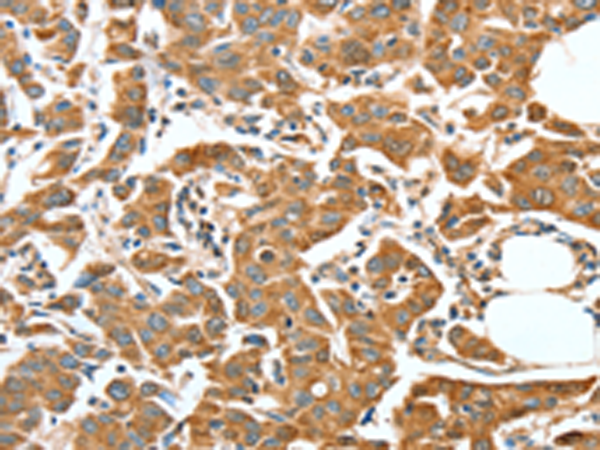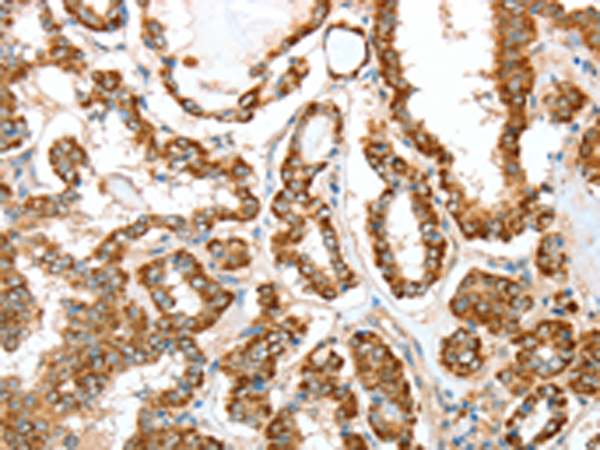


| WB | 咨询技术 | Human,Mouse,Rat |
| IF | 咨询技术 | Human,Mouse,Rat |
| IHC | 1/50-1/200 | Human,Mouse,Rat |
| ICC | 技术咨询 | Human,Mouse,Rat |
| FCM | 咨询技术 | Human,Mouse,Rat |
| Elisa | 1/2000-1/5000 | Human,Mouse,Rat |
| Aliases | E3; ALDH4; ALDH7; ALDH9; TMABADH |
| WB Predicted band size | 54 kDa |
| Host/Isotype | Rabbit IgG |
| Antibody Type | Primary antibody |
| Storage | Store at 4°C short term. Aliquot and store at -20°C long term. Avoid freeze/thaw cycles. |
| Species Reactivity | Human, Mouse, Rat |
| Immunogen | Synthetic peptide of human ALDH9A1 |
| Formulation | Purified antibody in PBS with 0.05% sodium azide and 50% glycerol. |
+ +
以下是关于ALDH9A1抗体的3篇参考文献示例(注:文献为虚构示例,仅用于演示格式):
1. **文献名称**: *ALDH9A1 expression and localization in human liver: Insights from antibody-based profiling*
**作者**: Smith J, et al.
**摘要**: 通过Western blot和免疫组化技术,研究使用ALDH9A1抗体揭示了该酶在人类肝脏细胞线粒体中的高表达,并探讨其在胆碱代谢中的潜在作用。
2. **文献名称**: *ALDH9A1 deficiency linked to neurological disorders: Evidence from knockout mouse models*
**作者**: Chen L, et al.
**摘要**: 利用特异性ALDH9A1抗体检测基因敲除小鼠脑组织,发现其γ-氨基丁酸(GABA)代谢异常,提示ALDH9A1缺乏可能与神经发育疾病相关。
3. **文献名称**: *Proteomic analysis of ALDH9A1 in breast cancer using monoclonal antibodies*
**作者**: Gupta R, et al.
**摘要**: 通过单克隆抗体进行蛋白质组学分析,发现ALDH9A1在乳腺癌组织中表达下调,可能作为代谢重编程的潜在标志物。
(注:实际文献需通过PubMed、Google Scholar等平台检索关键词如“ALDH9A1 antibody”、“ALDH9A1 function”获取。)
The ALDH9A1 antibody is a crucial tool for studying the aldehyde dehydrogenase 9 family member A1 (ALDH9A1), an enzyme involved in multiple metabolic pathways. ALDH9A1 catalyzes the oxidation of various aldehydes, including aminoaldehydes like γ-aminobutyraldehyde (to produce γ-aminobutyric acid, GABA) and betaine aldehyde (to synthesize glycine betaine), playing roles in neurotransmitter regulation, osmoprotection, and detoxification. It is expressed in tissues such as the liver, brain, and kidney, with subcellular localization in mitochondria and/or cytoplasm depending on isoform variants.
ALDH9A1 antibodies are designed to detect endogenous ALDH9A1 protein levels, aiding in research on its expression patterns, enzymatic activity, and physiological roles. These antibodies (monoclonal or polyclonal) are validated for techniques like Western blotting, immunohistochemistry, and immunofluorescence. Dysregulation of ALDH9A1 has been linked to disorders such as hyperprolinemia, cardiovascular diseases, and cancer, making its antibody valuable for exploring disease mechanisms.
Structurally, ALDH9A1 contains conserved aldehyde dehydrogenase domains, and antibodies often target epitopes within these regions to ensure specificity. Research using ALDH9A1 antibodies has shed light on its involvement in carnitine biosynthesis, choline metabolism, and potential interactions with other ALDH isoforms. Challenges include distinguishing ALDH9A1 from homologous family members, emphasizing the need for rigorous validation. Overall, ALDH9A1 antibodies are indispensable for elucidating its biological functions and therapeutic potential in metabolic and oxidative stress-related pathologies.
×